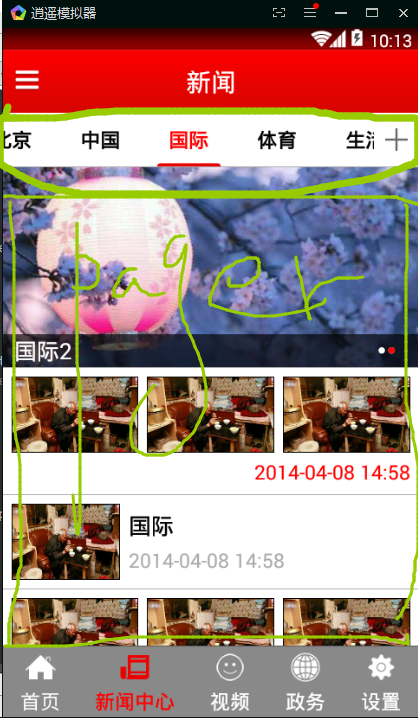TabPagerIndicator使用
本文共 1433 字,大约阅读时间需要 4 分钟。
 1 注意/在清单文件中配置activity/theme=
1 注意/在清单文件中配置activity/theme=
android:theme="@style/Theme.PageIndicatorDefaults">
// 2 (adpter中添加getPageTitle)
2 (adpter中添加getPageTitle)
//1.给viewPager设置数据适配器 MyPagerAdapter myPagerAdapter = new MyPagerAdapter(); pager.setAdapter(myPagerAdapter); //2.指示器和viewPager进行绑定 indicator.setViewPager(pager);
3 重点(修改选中文字的颜色,背景) values/style/tabPageIndicator
values/style/tabPageIndicator
@android:color/transparent 为加背景,,不能用@null
<item name="vpiTabPageIndicatorStyle">@style/Widget.TabPageIndicator</item>//这里
</style>
<style name="Widget"> </style> <style name="Widget.TabPageIndicator" parent="Widget"> <item name="android:gravity">center</item><item name="android:background">@drawable/vpi__tab_indicator</item>//背景
<item name="android:paddingLeft">22dip</item> <item name="android:paddingRight">22dip</item> <item name="android:paddingTop">12dp</item> <item name="android:paddingBottom">12dp</item> <item name="android:textAppearance">@style/TextAppearance.TabPageIndicator</item> <item name="android:textSize">12sp</item> <item name="android:maxLines">1</item> </style> <style name="TextAppearance.TabPageIndicator" parent="Widget"> <item name="android:textStyle">bold</item><item name="android:textColor">@color/vpi__dark_theme</item>//文字颜色
</style> <style name="Widget.IconPageIndicator" parent="Widget"> <item name="android:layout_marginLeft">6dp</item> <item name="android:layout_marginRight">6dp</item> </style></resources>
你可能感兴趣的文章
Node.js 历史
查看>>
Node.js 回调函数的原理、使用方法
查看>>
Node.js 在个推的微服务实践:基于容器的一站式命令行工具链
查看>>
Node.js 实现类似于.php,.jsp的服务器页面技术,自动路由
查看>>
Node.js 异步模式浅析
查看>>
node.js 怎么新建一个站点端口
查看>>
Node.js 文件系统的各种用法和常见场景
查看>>
Node.js 模块系统的原理、使用方式和一些常见的应用场景
查看>>
Node.js 的事件循环(Event Loop)详解
查看>>
node.js 简易聊天室
查看>>
Node.js 线程你理解的可能是错的
查看>>
Node.js 调用微信公众号 API 添加自定义菜单报错的解决方法
查看>>
node.js 配置首页打开页面
查看>>
node.js+react写的一个登录注册 demo测试
查看>>
Node.js中环境变量process.env详解
查看>>
Node.js中的EventEmitter模块:基本概念、使用方法和常见应用场景
查看>>
Node.js之async_hooks
查看>>
Node.js也分裂了-开源社区动态
查看>>
Node.js入门系列视频教程
查看>>
Node.js创建第一个应用
查看>>
